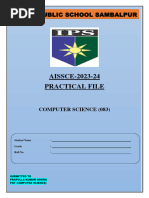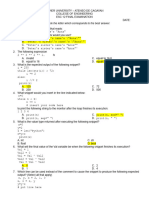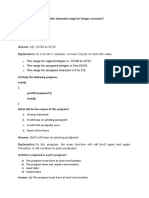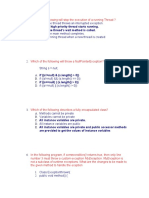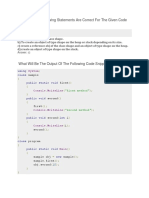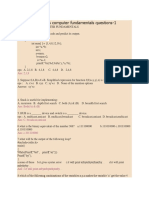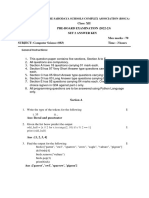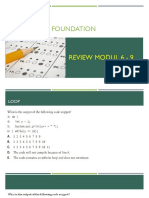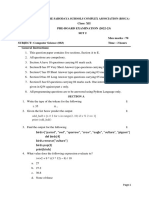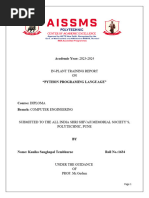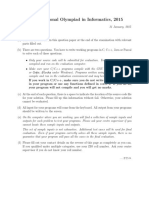Python Basic Assessment
Uploaded by
Usharani KPython Basic Assessment
Uploaded by
Usharani K1.What will be the output of above Python code?
str1="6/4"
print("str1")
A. 1
B. 6/4
C. 1.5
D. str1
Answer : D
Explanation: Since in print statement, str1 is written inside double quotes so it
will simply print str1 directly.
2.Which of the following is False?
A. String is immutable.
B. capitalize() function in string is used to return a string by converting the
whole given string into uppercase.
C. lower() function in string is used to return a string by converting the whole
given string into lowercase.
D. None of these.
Answer : B
Explanation: capitalize() function in string gives the output by converting only
the first character of the string into uppercase and rest characters into
lowercase.However, upper() function is used to return the whole string into
uppercase.
3.What will be the output of below Python code?
str1="Aplication"
str2=str1.replace('a','A')
print(str2)
A. application
B. Application
C. ApplicAtion
D. applicAtion
Answer : C
Explanation: replace() function in string is used here to replace all the existing
"a" by "A" in the given string.
4.Which of the following will give "David" as output?
If str1="John,David,Aryan"
A. print(str1[-7:-12])
B. print(str1[-11:-7])
C. print(str1[-11:-6])
D. print(str1[-7:-11])
Answer : C
Explanation: Slicing takes place at one index position less than the given second
index position of the string. So,second index position will be -7+1=-6.
5.What happens when ‘1’ == 1 is executed?
a) we get a True
b) we get a False
c) an TypeError occurs
d) a ValueError occurs
Answer: b
Explanation: It simply evaluates to False and does not raise any exception
6.Which one of the following is the correct way of declaring and initializing
a variable, x with the value 7?
A. declare x=7int x
x=7
B. int x=7
C. x=7
D. declare x=7
Answer : C
Explanation: The correct way of declaring and initializing a variable, x with
the value 7 is x=7.
7. The generation based on VLSI microprocessor.
a) 1st
b) 2nd
c) 3rd
d) 4th
Answer: d
Explanation: The 4th gen was VLSI microprocessor based. The period of fourth
generation: 1972-1990.
8. ULSI stands for?
a) Ultra Large Scale Integration
b) Under Lower Scale Integration
c) Ultra Lower Scale Integration
d) Under Large Scale Integration
Answer: a
Explanation: It stands for Ultra Large Scale Integration. It is a part of the fifth
generation computers
9. The period of ________ generation was 1952-1964.
a) 1st
b) 2nd
c) 5th
d) 4th
Answer: b
Explanation: The period of the 2nd generation is 1952-1964. The period of the
first generation was 1942-1954.
10. Which of the following statements assigns the value 25 to the variable x
in Python:
A. x << 25x ← 25
B. x = 25
C. x := 25
D. int x = 25
E. x << 25
Answer : B
You might also like
- Class-12-Computer Science Practical File 2023-2475% (24)Class-12-Computer Science Practical File 2023-2445 pages
- Advanced C++ Interview Questions You'll Most Likely Be AskedFrom EverandAdvanced C++ Interview Questions You'll Most Likely Be AskedNo ratings yet
- Int F (Int N) (Static Int I 1 If (N 5) Return N N N+i I++ Return F (N) )No ratings yetInt F (Int N) (Static Int I 1 If (N 5) Return N N N+i I++ Return F (N) )9 pages
- COMPUTER APPLICATIONSCL-10 2023-24 PREBOARD (1)No ratings yetCOMPUTER APPLICATIONSCL-10 2023-24 PREBOARD (1)6 pages
- Rev 1 _ q With Ans _python Basics and Flow Control 17.08.24No ratings yetRev 1 _ q With Ans _python Basics and Flow Control 17.08.247 pages
- MCQ On Understanding Lists in Python For Class 7No ratings yetMCQ On Understanding Lists in Python For Class 75 pages
- Namma Kalvi 12th Computer Science Chapter 6 Study Material em 214987No ratings yetNamma Kalvi 12th Computer Science Chapter 6 Study Material em 2149878 pages
- Oracle Java Foundation: Review Modul 6 - 9100% (1)Oracle Java Foundation: Review Modul 6 - 943 pages
- 20112024105941Class 9 Computer Applications 2nd Term Master WorksheetNo ratings yet20112024105941Class 9 Computer Applications 2nd Term Master Worksheet5 pages
- ISC Computer Science Question Paper 2016 Solved For Class 12 - A Plus Topper 3100% (1)ISC Computer Science Question Paper 2016 Solved For Class 12 - A Plus Topper 31 page
- Copy of Copy of CSBS Updated 25.07.2023No ratings yetCopy of Copy of CSBS Updated 25.07.202339 pages
- Software Design and Development HSC NotesNo ratings yetSoftware Design and Development HSC Notes77 pages
- Mayer C. Coffee Break Python Slicing. 24 Workouts To Master Slicing in Python 2019 PDFNo ratings yetMayer C. Coffee Break Python Slicing. 24 Workouts To Master Slicing in Python 2019 PDF89 pages
- Indian National Olympiad in Informatics, 2015No ratings yetIndian National Olympiad in Informatics, 20156 pages
- ITA 6017 - Python Programming Challenging Cyclesheet Name - Anjali Sharma Reg. No. - 19MCA0210No ratings yetITA 6017 - Python Programming Challenging Cyclesheet Name - Anjali Sharma Reg. No. - 19MCA021015 pages
- National Institute of Technology Rourkela: Course Syllabus 07 MAR 2021 20:21No ratings yetNational Institute of Technology Rourkela: Course Syllabus 07 MAR 2021 20:211 page
- ATrack AP Protocol Document 1.3.8. 2018 PDFNo ratings yetATrack AP Protocol Document 1.3.8. 2018 PDF131 pages
- Sapt 5 SECTIUNEA 3 Lectia 3 - String ProcessingNo ratings yetSapt 5 SECTIUNEA 3 Lectia 3 - String Processing47 pages

